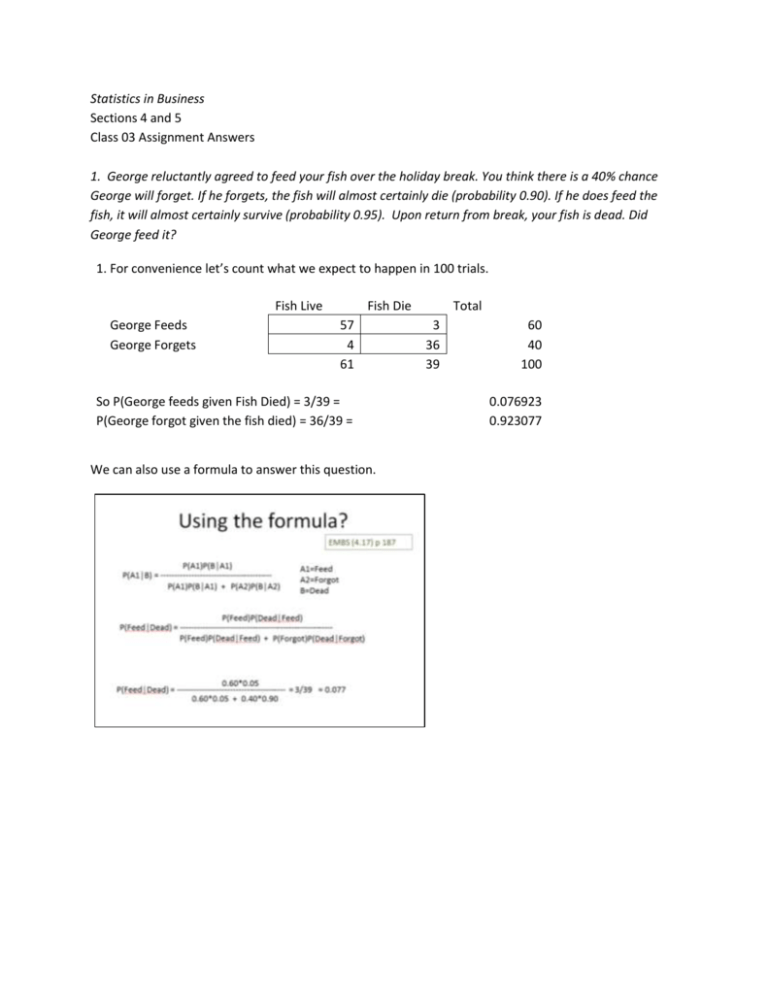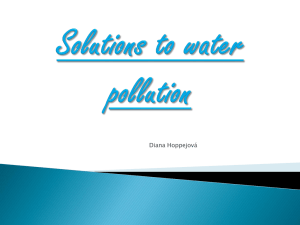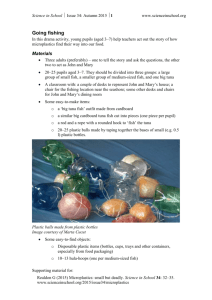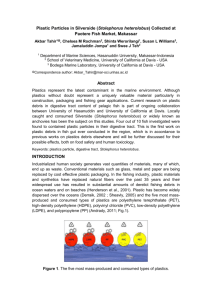Class 03 Assignment Answers
advertisement

Statistics in Business Sections 4 and 5 Class 03 Assignment Answers 1. George reluctantly agreed to feed your fish over the holiday break. You think there is a 40% chance George will forget. If he forgets, the fish will almost certainly die (probability 0.90). If he does feed the fish, it will almost certainly survive (probability 0.95). Upon return from break, your fish is dead. Did George feed it? 1. For convenience let’s count what we expect to happen in 100 trials. Fish Live George Feeds George Forgets Fish Die 57 4 61 So P(George feeds given Fish Died) = 3/39 = P(George forgot given the fish died) = 36/39 = We can also use a formula to answer this question. Total 3 36 39 60 40 100 0.076923 0.923077 2. (EMBS problem 41, page 190) A consulting firm submitted a bid for a large research project. The firm’s management initially judged they had a 50/50 chance of getting the project. However, the agency to which the bid was submitted subsequently requested additional information on the bid. Past experience indicates that for 75% of the successful bids and 40% of the unsuccessful bids the agency requested additional information. Now that the agency has requested additional information, what are the chances the firm’s bid will be successful? 2. For convenience, let's count what to expect to happen in 100 trials Fail Success Total 20 37.5 30 12.5 50 50 request for info no request So P(Success given request for info) = 37.5/57.5 = 57.5 42.5 100 0.652174 3. (EMBS problem 37, page 184) Visa Card USA studied how frequently young consumers (ages 18 to 24) use plastic in making purchases. (AP, January 16, 2006). The results of the study provided the following probabilities: The probability that a consumer uses plastic when making a purchase is 0.37 Given that the consumer uses plastic, there is a 0.19 probability the consumer is young (18 to 24) and a 0.81 probability the consumer is not young. About 14% of US purchases are made by young consumers (18 to 24). Given that the consumer is young, what is the probability that consumer used plastic? Given that the consumer is not young, what is the probability that consumer used plastic? Are age and using plastic independent events? 3. For convenience, let's count what we expect to happen in 1,000 purchases. not Young not Plastic 69.7 560.3 630 Total 70.3 299.7 370 So P(plastic given young) = 70.3/140 = P(plastic given not young) = 299.7/850 = Young and plastic are NOT independent because the probability of using plastic is higher (than 37%) given the consumer is young. 140 860 1000 0.502143 0.348488 4. After a semester of practice, Bo claims to be able to flip heads. What would be the more challenging test of Bo’s supposed skill……requiring at least 8 heads in 10 flips or 60 in 100? 4. Assume he cannot "flip head" and that the number of heads will follow the binomial distribution with p=0.5. P(8 or more) = 1 - P(7 or fewer) = 1 - BINOMDIST(7,10,.5,true) = 0.054688 P(60 or more in 100) = 1 - BINOMDIST(59,100,.5,true) = 0.028444 So flipping at least 60 in 100 is more difficult than 8 or more in 10. 5. Tim Abromaitis, a 78% free throw shooter, will attempt three free throws late in a close game. What are the chances he’ll make at least two of the three attempts? State any assumption you need to make to answer this question. 5. Assume free throw outcomes are independent and 0.78 is based on enough data so that it is a probability. The number of successes in three trials will be binomially distributed. P(2 or more) = 1- P(1 or fewer) = 1 - BINOMDIST(1,3,.78,true) =10.123904 = 0.876096









